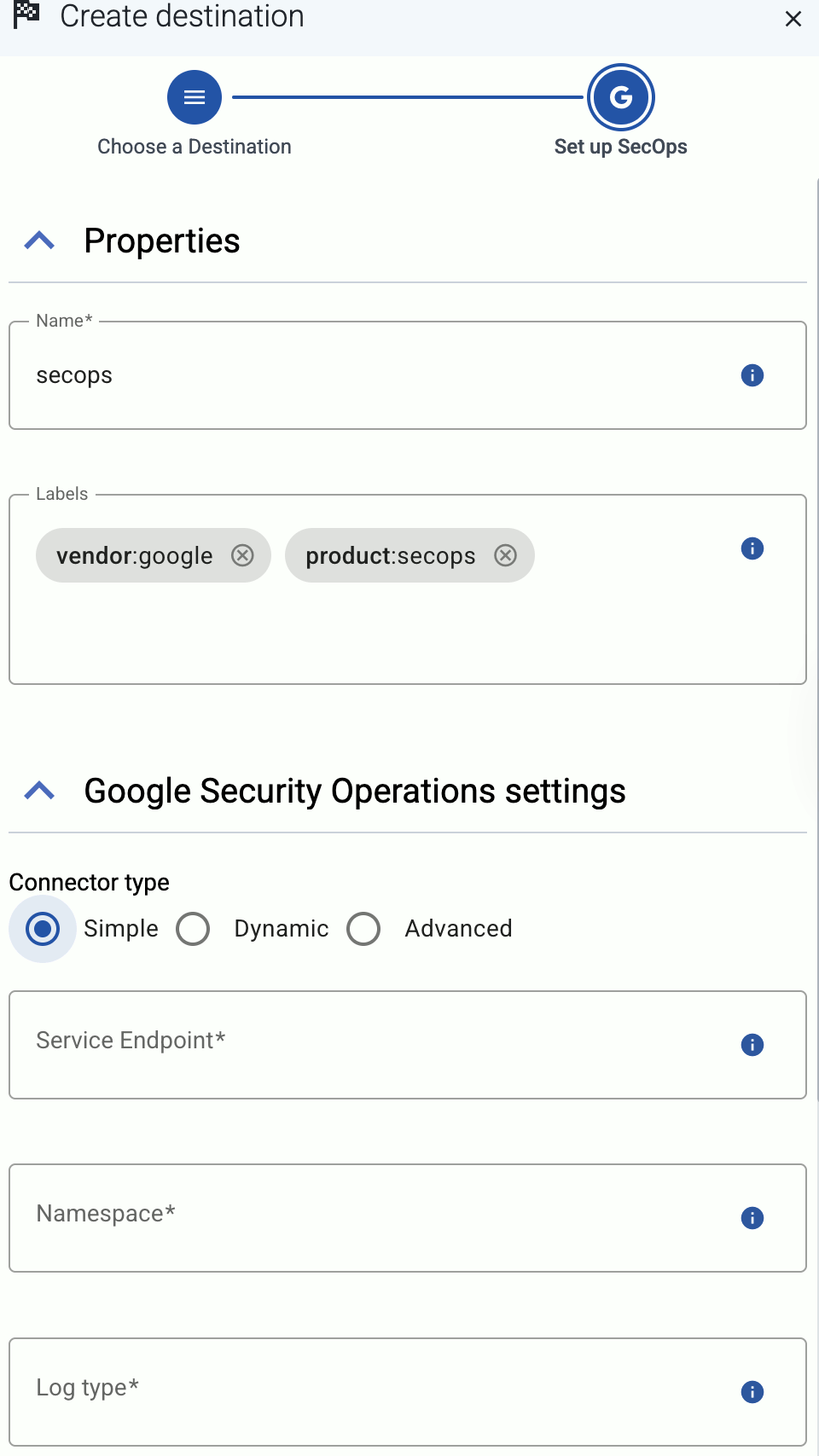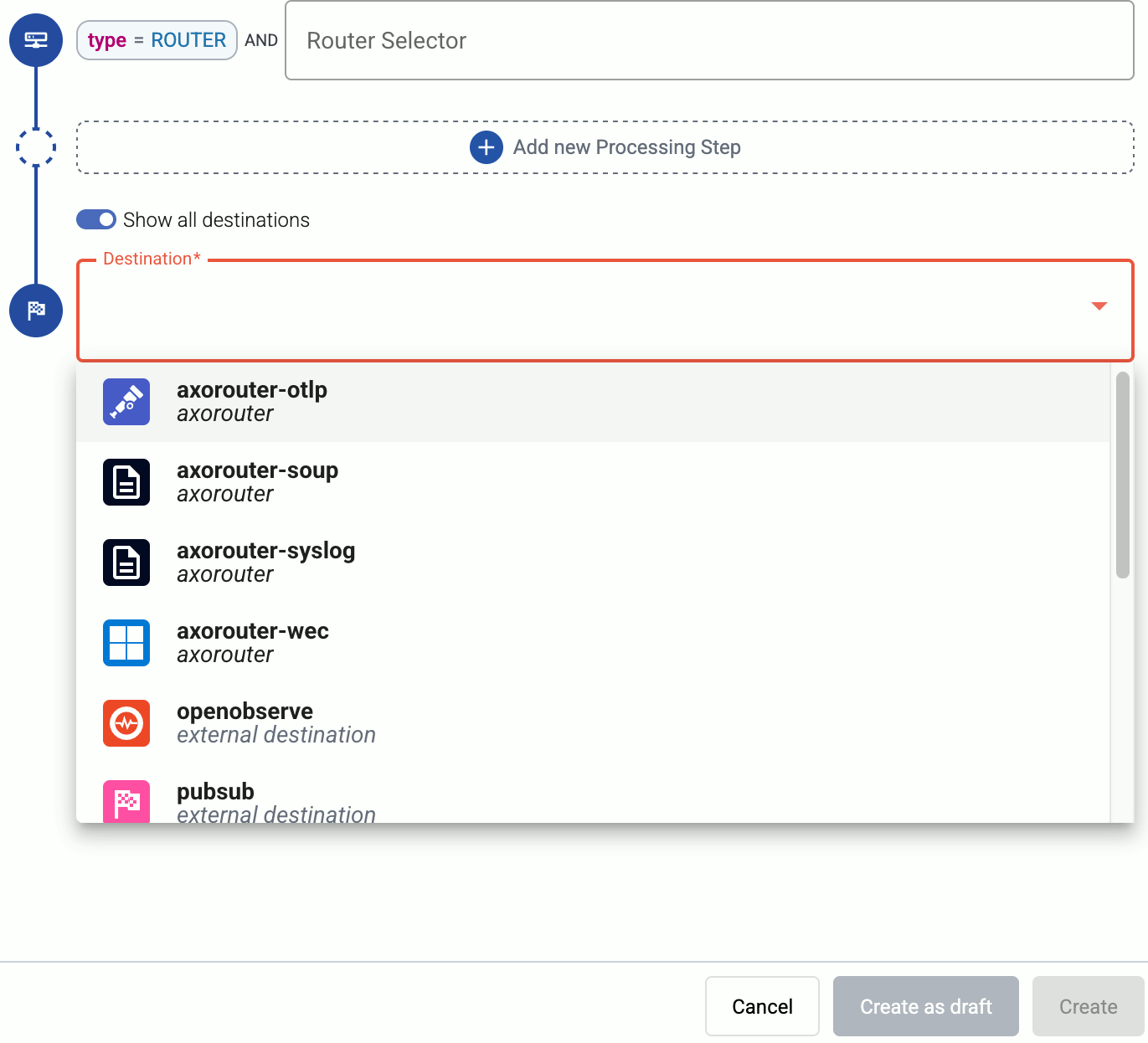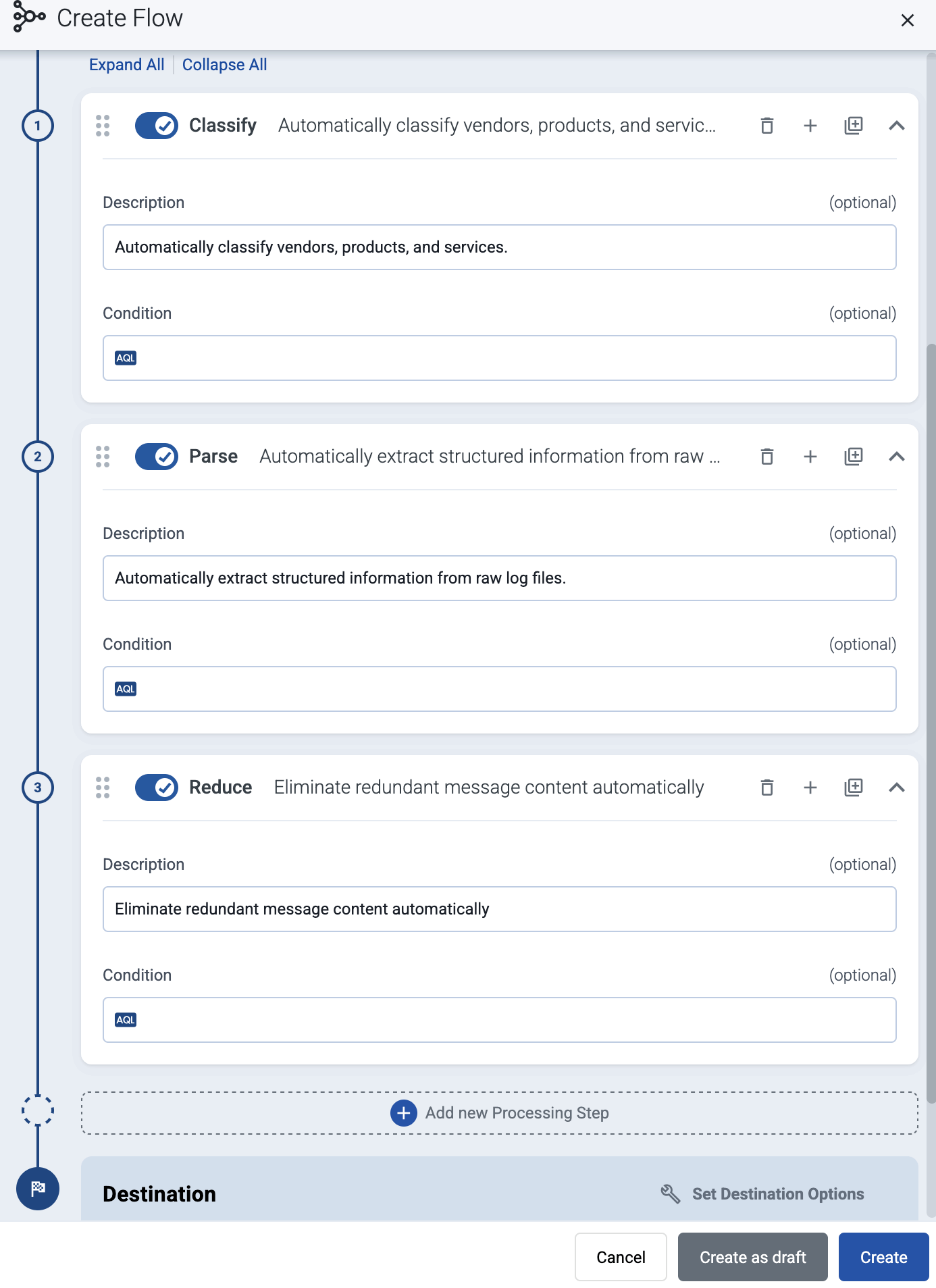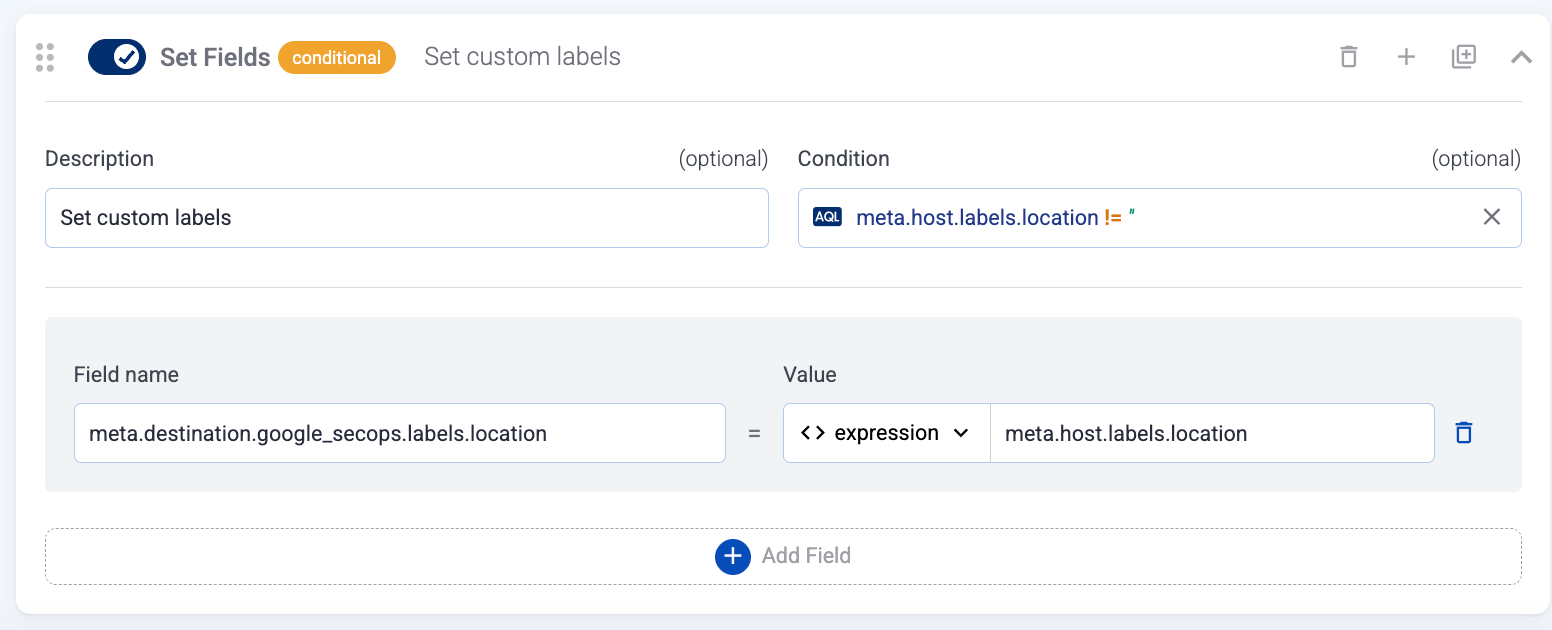Google Security Operations (SecOps)
Google Security Operations (SecOps): A cloud service designed for enterprises to privately retain, analyze, and search the massive amounts of security and network telemetry they generate.
To add a Google Security Operations (SecOps) destination to Axoflow, complete the following steps.
Prerequisites
- A Google SecOps subscription.
- An IAM service account that Axoflow uses for authentication.
Steps
-
Create a new destination.
- Open the AxoConsole.
- Select Destinations > + Create New Destination.
-
Configure the destination.
-
Select SecOps.
-
Select which type of configuration you want to use:
- Simple: Send all data into a namespace with a single log type.
- Dynamic: Send data to a namespace with a log type based on the content or metadata of the incoming messages (or to a default namespace/log type).
- Advanced: Specify the full endpoint URL.
-
Enter a name for the destination.

-
Enter the URL endpoint for the destination.
- Simple and Dynamic: Enter base URL for the regional service endpoint to use into the Service Endpoint field, for example,
https://malachiteingestion-pa.googleapis.comfor the US region. - Advanced: Enter the full URL to use for ingesting logs into the Endpoint URL field, for example,
https://malachiteingestion-pa.googleapis.com/v2/unstructuredlogentries:batchCreate.
- Simple and Dynamic: Enter base URL for the regional service endpoint to use into the Service Endpoint field, for example,
-
Specify the log type to send the data to.
- Simple and Advanced: Enter the Log type to assign to the data. All data will be assigned the specified log type.
- Dynamic: Enter the Default log type. The data will be sent with the specified log type unless it is set during the processing of the message (for example, by the automatic classification, or the processing steps of the Flow).
You can use AxoSyslog macros in this field.
-
Enter the unique ID of your Google SecOps instance into the Customer ID field.
-
(Optional) Specify the namespace to send the data to. Usually it’s not needed to use namespaces.
- Simple and Advanced: Enter the Namespace where to send the data. All data will be sent to this namespace.
- Dynamic: Enter the Default namespace. The data will be sent into this namespace unless it is set during the processing of the message (for example, by the processing steps of the Flow).
You can use AxoSyslog macros in this field.
-
Configure the authentication method to access the GCP project.
- Automatic (ADC): Use the service account attached to the cloud resource (VM) that hosts AxoRouter.
- Service Account File: Specify the path where a service account key file is located (for example,
/etc/axorouter/user-config/serviceaccount.json). You must manually copy that file to its place, currently you can’t distribute it from Axoflow.
-
(Optional) Set other options as needed for your environments.
- Timeout: The number of seconds to wait for a log-forwarding request to complete, and attempt to reconnect the server if exceeded. If the timeout is exceeded, AxoRouter attempts to reconnect the destination. The default (
0) is unlimited. For more details, see the AxoSyslog documentation.
- Batch Bytes: Sets the maximum size of payload in a batch. If the size of the messages reaches this value, AxoRouter sends the batch to the destination even if the number of messages is less than the value of the batch lines option.
- Batch Lines: Number of lines sent to the destination in one batch. AxoRouter waits for this number of lines to accumulate and sends them off in a single batch. Increasing this number increases throughput as more messages are sent in a single batch, but also increases message latency. For more details, see the AxoSyslog documentation.
- Batch Timeout: Maximal time in milliseconds to wait for a batch to be filled before sending it. The default value (
-1) means that the batch should be full before sending, which may result in a long wait if the incoming traffic is low. For more details, see the AxoSyslog documentation. - Number of Workers: Used for scaling the destination in case of high message load. Specifies the number of worker threads AxoRouter uses for sending messages to the destination. The default is 1. If high message throughput is not a concern, leave it on 1. For maximum performance, increase it up to the number of CPU cores available on AxoRouter. For more details, see the AxoSyslog documentation.
- Timeout: The number of seconds to wait for a log-forwarding request to complete, and attempt to reconnect the server if exceeded. If the timeout is exceeded, AxoRouter attempts to reconnect the destination. The default (
-
Select Create.
-
-
Create a flow to connect the new destination to an AxoRouter instance.
-
Select Flows.
-
Select Create New Flow.
-
Enter a name for the flow, for example,
my-test-flow.
-
In the Router Selector field, enter an expression that matches the router(s) you want to apply the flow. To select a specific router, use a name selector, for example,
name = my-axorouter-hostname.It also makes more complex filtering possible, using the Equals, Contains (partial match), and Match (regular expression match) operators. Note that:
- To execute the search, click Search, or hit ESC then ENTER.
- AxoConsole autocompletes the built-in and custom labels and field names, as well as their most frequent values, but doesn’t autocomplete labels and variables created by data parsing and processing steps.
- You can use the AND and OR operators to combine expressions, and also parenthesis if needed. For details on AQL, see AQL operator reference.
- The precedence of the operators is the following: parentheses, AND, OR, comparison operators.
- Use the usual keyboard shortcuts to undo (⌘/Ctrl + Z) or redo (⌘/Ctrl + Shift + Z) your edits.
-
Select the Destination where you want to send your data. If you don’t have any destination configured, you can select + Create New in the destination section to create a new destination now. For details on the different destinations, see Destinations.
By default, you can select only external destinations. If you want to send data to another AxoRouter, enable the Show all destinations option, and select the connector of the AxoRouter where you want to send the data.

-
(Optional) To process the data transferred in the flow, select Add New Processing Step. For details, see Processing steps. For example:
- Add a Classify, a Parse, and a Reduce step, in that order, to automatically remove redundant and empty fields from your data.
- To select which messages are processed by the flow, add a Select Messages step, and enter a filter into the AQL Expression field. For example, to select only the messages received from Fortinet FortiGate firewalls, use the
meta.vendor = fortinet AND meta.product = fortigatequery. - Save the processing steps.

-
Select Create.
-
The new flow appears in the Flows list.

-
Related message fields
You can use the following message fields to modify messages sent to this destination using processing steps.
For example, you can add your custom labels using a Set Fields processing step to meta.destination.google_secops.labels:

Note that sending custom labels to SecOps can have significant performance impact. Make sure to increase the number of workers (More options > Number of Workers), ideally to have at least one worker for each custom label.